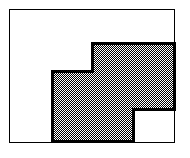 8.5. Advantages of Quadtrees
8.5. Advantages of Quadtrees  8.5. Advantages of Quadtrees
8.5. Advantages of Quadtrees An advantage of quadtrees is that an image can be compactly represented. The compactness of the quadtree depends entirely on the image. An image with large areas of a single colour will become very compact, while an image that has a different colour for every pixel will yield no advantage at all. (Hunter and Stiglitz,1979)
Because of its advantages quadtrees have become very
popular in GIS and spatial data representation. They are
extremely useful for neighbourhood operations (Burroughs 1986). In GIS these
include :
This makes quadtrees particularly useful in applications requiring images to be overlaid. They are also efficient for a number of image processing operations eg computing perimeters, labelling connected components, finding genus of an image, and computer centroids (Samet,1981).
There are also many algorithms available for the traversal and manipulation of trees in their many forms, and quadtrees can take full advantage of these. A rotation of 90 degrees anti- clockwise is achieved simply by moving each node as shown:
Burroughs (1986) and Samet (1990) also mention that quadtrees are useful in varying
the resolution of an object. For example let us use the quadtree
in figure 8.4 which represents the image in figure 8.1.a. If we want to vary the
resolution on this image we can simply change all the grey nodes
on level 1 to black nodes. This will produce the new image in figure 8.5.
The final advantage of quadtrees is that there are already many available codes and algorithms for the data structure (see codes).

Fig. 8.5 : Varied Resolution of Quadtree












